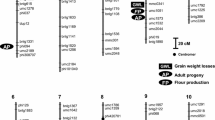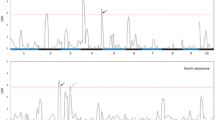Abstract
The European corn borer (ECB, Ostrinia nubilalis Hübner) is a major pest of maize in Central Europe. We mapped and characterized quantitative trait loci (QTLs) involved in resistance of maize against ECB damage, compared them with QTLs for agronomic traits, and evaluated the usefulness of marker-assisted selection (MAS) for improving ECB resistance in early maturing European maize germplasm. A total 226 F3 families from the cross D06 (resistant) × D408 (susceptible), together with 93 RFLP and two SSR markers were used for the QTL analyses. For each F3 family we measured the length of tunnels produced by larval stalk mining (TL), stalk damage ratings (SDR), and relative grain yield (RGY) in field experiments, with two replications in two environments in 1 year. The agronomic traits comprised grain yield under insecticide protection (GYP) and manual ECB larval infestation (GYI), the date of anthesis (ANT), and the in vitro digestibility of organic matter (IVDOM) of stover. Estimates of genotypic variance (σ2 g) were highly significant for all traits. Six QTLs for TL and five QTLs for SDR were detected, explaining about 50.0% of σ2 g. Most QTLs showed additive gene action for TL and dominance for SDR. No QTL was found for RGY. The number of QTLs detected for the agronomic traits ranged from two for GYI to 12 for ANT, explaining 12.5 to 57.3% of σ2 g, respectively. Only a single QTL was in common between the two resistance traits, as expected from the moderate trait correlation and the moderate proportions of σ2 g explained. Based on these results, MAS for improving ECB resistance can be competitive when cost-effective PCR-based marker systems are applied. However, it remains to be established whether the putative QTL regions for ECB resistance detected in the population D06 × D408 are consistent across other early maturing European maize germplasms.
Similar content being viewed by others
Author information
Authors and Affiliations
Additional information
Received: 20 December 1999 / Accepted: 6 June 2000
Rights and permissions
About this article
Cite this article
Bohn, M., Schulz, B., Kreps, R. et al. QTL mapping for resistance against the European corn borer (Ostrinia nubilalis H.) in early maturing European dent germplasm. Theor Appl Genet 101, 907–917 (2000). https://doi.org/10.1007/s001220051561
Issue Date:
DOI: https://doi.org/10.1007/s001220051561




